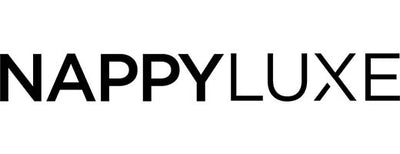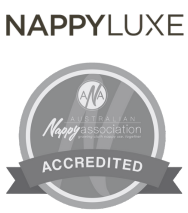10 Ways to Prevent Cloth Nappy Leaks

You shouldn't get leaks using quality reusable nappies any more than you may get using disposable nappies.
If you are experiencing leaks, something is wrong.
Here are 10 ways to avoid leaks:
1. Size the cloth nappy correctly
The snaps on the front of a OSFM cloth nappy are the “rise snaps” which allow you to adjust the nappy as your baby grows.
If you're used to using disposable nappies, this means the nappy ranges from a size 1 roughly up to a size 5.
A common mistake that new cloth nappy users make is to set the nappy on too large a setting.
You can see why people make this mistake, with disposable nappies, a larger size = more surface area covered and therefore less leaks right? Not quite when it comes to reusables.
With cloth nappies, if the nappy is sized too large, the absorbent inserts don’t sit close enough to the baby’s urine stream.
This can result in the urine “missing” the absorbent inserts and hitting the edges of the nappy while the baby rolls and moves.
This is where the elastics are sewn in, and if the liquid hasn't had a chance to be absorbed it is possible it can leak.
This is why you’re best off to size nappies appropriately to the size of your baby to allow the inserts to absorb the liquid before reaching the elasticated edges.
2: Get the fit right
The fit of a washable nappy differs slightly from a disposable.
The main difference can be described as granny pants vs low-rise bikini briefs:
Disposable nappies are like granny pants - they sit far up your baby’s back and tummy, and far down around the legs.
Cloth nappies are like low-rise bikini briefs - they are small, sitting very low on the back and tummy, and the elastics are tucked neatly into the baby’s groin creases.
You should be able to see your baby's belly button while they're wearing a cloth nappy.
The tummy of a cloth nappy is usually a bit looser than a disposable nappy, which is especially important when your baby is at sitting age to allow them movement.
Ensuring you have followed our fit guide below will mean your baby is comfortable and you won’t get a fit-related leak.

3: Change the nappy every 2-3 hours
All nappies, both disposable and cloth, are advised to be changed every 2-3 hours during the day for hygiene reasons and to keep your baby free from nappy rash.
With a standard cloth nappy, you may find leaks occurring if you aren’t changing the nappy frequently enough.
When you’re wanting to use cloth nappies overnight or for longer naps, you will need to add additional absorbency.
This can be done by purchasing a pack of cloth nappy trifolds, which are the ideal way to see your baby through the night.
4: Use the correct amount of absorbency
If a leak has occurred and the insert/s inside are completely saturated / sopping wet, this may indicate that it’s time to start using more inserts to increase the absorbency.
NappyLuxe cloth inserts are made from bamboo terry which is ideal to see your baby through between nappy changes during the day.
Your baby will go through various phases of light and heavy wetting as they grow.
If you find your baby needs a little extra absorbency on top of the 2 standard inserts, additional insert packs can be purchased to supplement your nappy stash.
5: Size clothing up
Cloth nappies are a little more bulky than disposable nappies, and if tight clothing is pressing on the nappy then it's possible this can lead to leaks.
That's why it's a good idea to use larger sized clothing for your baby.
Another perk of sizing up is that it’s easier to get clothing on and off your baby and dress them quicker.
Pants / trousers with tightly elasticated waistbands can also add pressure to the front of the nappy and cause leaks.
Sizing up pants helps to alleviate pressure to ensure the elastic of the pants doesn’t dig into the top of the nappy and cause a leak.
6: Button bodysuits with the middle popper
Using all 3 poppers to fasten your baby’s bodysuits can put unwanted pressure on your baby’s thighs where the nappy sits, which can cause moisture to wick onto the clothing.
A hack we recommend is to only do up the middle popper, which relieves this pressure.
7: Wash and dry correctly
Modern cloth nappy covers shouldn’t be washed over 60 degrees, as the heat can damage the water-resistant PUL layers and cause them to delaminate.
Tumble drying on hot or drying them in the sun can also have this negative effect.
Once delaminating has occurred due to this heat damage, the nappies cannot be recovered, and will likely start to leak.
We therefore recommend not exposing nappy covers to heat over 60 degrees, and to follow our detailed cloth nappy washing guide.
8: For boys - point the penis down
This goes for both disposable and reusable nappies.
If you forget to point the penis down and the nappy waist isn’t tight enough, you guessed it: the urine can spray straight up and out the top of the nappy.
By getting into the habit of always pointing the penis down, you can be sure to avoid these kinds of leaks.
Another tip for boys is to fold the small insert at the front of the nappy to ensure the absorbency sits where it's needed most.
9: Flooding
If you’ve had a leak, ruled out the other possible causes in this post, and found that the inserts weren’t fully saturated or the nappy wasn’t on for long, it’s possible that flooding was the cause.
Some baby’s have an exceptionally fast urine stream, and as the wee comes out, the inserts simply cannot absorb it fast enough.
This is what is meant by flooding.
To combat this you can try a few things:
Turn the inserts over - NappyLuxe inserts are topped with a stay dry layer of microfleece for added comfort for your baby. However, if your baby is flooding the nappy you maybe find that turning the inserts over and just laying them in the nappy rather than snapping them in, the bamboo side of the insert absorb the urine faster.
If this fails, you can add a small sized face washer to the nappy next to your baby’s skin. NappyLuxe cloth wipes do this job effectively without adding much bulk.
10: Choose a premium brand
If you are still getting leaks, it's time to consider a premium brand.
NappyLuxe reusable nappies have been designed with multiple leak-preventing features including double leg elastics and a double elasticated back panel to ensure all mess is contained. These are just a few reasons why NappyLuxe is loved by experienced cloth nappy users across Australia.
Watch our customer video reviews and read our 5 star reviews.
Ready to give NappyLuxe a try? Buy a discounted cloth nappy trial pack or bundle deal.
We hope these tips help troubleshoot your cloth nappy leaks. If you have any questions, please feel free to reach out for more advice.
Shop Cloth Nappies NowBlog posts
How To Use Wool Nappy Covers At Night (Benefits & Wash guide)
Best Cloth Nappies Australia [What Features Do Top Brands Have In Common]
The 5 Top Uses For Cloth Wipes Revealed
Get 10% off your first order
Plus get notified about promotions, new releases and journal updates.





















